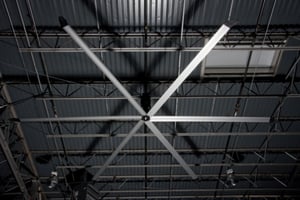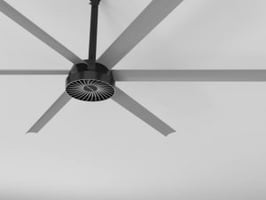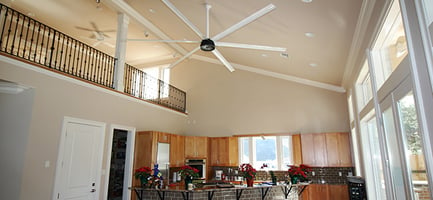Proper installation of your HVLS ceiling fan is essential. It ensures your fan is running at peak...
How to Improve High Ceiling Air Circulation in Warehouses
Why Is It Difficult to Cool a Facility with High Ceilings?
High ceiling air circulation in warehouses and other large buildings can be difficult. In addition to air circulation, open spaces with high ceilings pose particular challenges to keep cool. Even if you have an efficient HVAC system, the amount of space between the ceiling and floor makes circulating cold air a challenge. Because there is more room for hot air to rise, there is a greater tendency for “pockets” of hot and cold air to develop in these types of buildings. These problems are compounded by the hot sun beating down on the roof during the summer months. Those uneven levels of air, or pockets of hot and cold air, throughout a building can compromise comfort. Depending on the weather conditions, air temperatures can vary from 10-20 degrees due to the layering effect of large pockets of air with various temperatures, otherwise known as air stratification.
While some facility managers might deal with this challenge by simply cranking up their HVAC system, this can lead to elevated energy costs and excessive strain on cooling systems. Increasing airflow by destratifying the air is the most efficient way to help keep a building with high ceilings cool. So, what does it mean to destratify? Well, before we can explain destratification, one needs to know what stratification is.
What Is Air Stratification?
Air stratification, simply put, is the layering effect of large pockets of air with various temperatures. Every building has open space that contains thermal air layers with different temperatures. These layers are called stratum and form gradient temperature from the floor up to the ceiling. As hot air rises, it spreads out across the area and becomes denser. It is often trapped at the ceiling level. When this happens, the floor level becomes cooler often decreasing the temperature by 1-2 degrees every 3-foot increment of height. The higher the ceiling the cooler the floor level.
How does air stratification affect your facility?
It causes your HVAC system to work harder and cycle longer trying warm your space. When the HVAC system cycles down or shuts off, the area becomes cooler more quickly. This leads to an overall rise in utility costs, an increased chance of premature equipment failure, and increased energy bills.
What Is Destratification?
Once strata, or layered temperatures, are formed in a room or area and are trapped at the ceiling level, the process needs to be reversed. The pockets of layered air need to be broken up. Destratification is the act of controlling and changing the natural process of thermal stratification. Destratification will help to break up the pockets of cold and hot air, to help equalize the temperature throughout the area.
Because the outside weather conditions cannot be controlled, heating, ventilation, and air conditioning are used to help with destratification. However, air conditioning systems often need help. This is where HVLS fans come into play. Energy-efficient HVLS fans and axial fans can help destratify the air and, ultimately, help with heating and cooling effectively.
Why Does Cooling Your Ceiling Matter?
The airflow that is generated by fan destratification provides the necessary force and circulation to move the warm and hot air from the ceiling back towards the floor. This matters because it increases comfort, overall.
When you have machinery and multiple people working in one area, the heat radiates from both the machinery and warm bodies. When that heat is mixed with the original heat source, it can often become too hot. A NASA study found that when the effective temperature of a room rises, it greatly affects the output (productivity) and accuracy of the employees. This is most notable as temps reach above 80°. High temps cause mistakes, and mistakes affect the safety of your employees.
HVLS fans can help not only distribute the warm air across the area but also help to keep employees from overheating. This will also help your workers’ overall accuracy and productivity levels.
How Can I Improve High Ceiling Air Circulation in My Warehouse?
HVAC alone does not maximize efficiency in a high-ceiling facility. It’s true that HVAC systems can help increase the amount of cold air in a facility with high ceilings, but that doesn’t necessarily lead to a colder space. Because of air stratification, it can still feel hot in a building even if the air conditioning is running at a relatively high level.
Using HVAC by itself to cool a facility with high ceilings also puts undue strain on the HVAC system. In the hotter summer months, cooling has to be cranked up to a high level. This can increase your costs. Furthermore, facilities with high ceilings also require more ductwork, which means there are more places for leaks. That costs money. Even if leaks are fixed right away, running HVAC systems at a high level shortens their lifespan. So what can you do to help yourself? The answer is simple and cost-effective. Add HVLS fans.
How HVLS Fans Efficiently Cool High-Ceiling Warehouses
HVLS fans are designed to distribute air efficiently. In a facility with elevated ceilings where there is more room for stratification, HVLS fans can be used in tandem with HVAC systems to move cooler air around so that it is evenly dispersed. This will help to alleviate the hot and cold pockets of air in the space. This provides a number of benefits for a space with high ceilings:
- Makes employees feel cooler and more comfortable while they are working. An HVLS fan can lower the effective temperature by as much as 8°.
- Decreases the strain on the facility’s HVAC system. HVLS fans can allow you to lower the tonnage of your air conditioning by 25% or more.
- Improves air quality by more efficiently moving stale air out of the building.
Additional Benefits of HVLS Fans for Warehouse Spaces
Summer and Winter Benefits
When it’s hot and humid in the summer, you may experience a drop in productivity. MacroAir HVLS fans run in a forward direction, moving an immense amount of air all around your facility, from ceiling to floor. This additional airflow from our big HVLS ceiling fans makes your facility feel cooler, keeps your employees comfortable, keeps your customers comfortable, improves worker productivity, and keeps your customers coming back.
For complete year-round performance, our fans can spin in the opposite direction during winter to push warm air towards the floor and better distribute the warm air trapped in your ceiling. This eases your heating usage and provides further cost savings. Not to mention it helps keep your facility warmer through the colder winter months. Most importantly, this reverse operation keeps your employees more comfortable.
Reduced Pollutants for Cleaner Indoor Air
Stale, stagnant air is full of pollutants that can affect not only your products but also your employees. HVLS ceiling fans help with air circulation and can minimize the risk of sick building syndrome (SBS). Sick building syndrome is caused by stagnant, polluted air from chemical fumes, volatile organic compounds, pollen, and bio-aerosols. Sick building syndrome typically causes headaches, dizziness, and nausea while inside the building and resolves once outside the building. Using an HVLS ceiling fan reduces pollutants sitting at the floor level and increases ventilation, providing better air quality for employees and customers.
Reduce Energy Costs
With proper installation and when used at the appropriate speed and direction, HVLS fans contribute to increased energy savings. In fact, they can help you save up to 30% on your warehouse energy expenses.
Eliminate Condensation
HVLS fans help reduce condensation. They circulate warm, humid air that is trapped in the ceiling and push it towards the warmer ground. If you have ever noticed water dripping from the ceiling or collecting on walls in industrial and commercial buildings or warehouses, more than likely, it is not a leak; it is internal condensation. Because temperatures fluctuate when colder air comes in contact with warm air, or gets below the dew point level, a build-up of water or condensation happens. Condensation is a health hazard not only for you but also for your employees, product, and machinery. One freight company dealing with moisture issues installed MacroAir fans to help solve their problem. According to Geodis Wison Freight Forwarding,
“Chronic excess moisture was creating a dangerous condition in our Miami, FL warehouse facility known as Sweating Slab Syndrome (SSS). Our HVAC system couldn’t keep up with the humidity, and we had wet floors and mold. Installing three MacroAir AVD 550 fans reduced the condensation and resolved our SSS problems.”
THE BOTTOM LINE
If your space has high ceilings, it’s important to select an HVLS fan that provides sufficient airflow and coverage. MacroAir’s fans are able to move a massive amount of air, and the largest models can cover a space as large as 22,000 square feet. With the right HVLS ceiling fan or set of ceiling fans, you can make cooling your high ceiling facility a breeze.
“I love how much the fans helped out my manufacturing, keeping the temperature on the floor more consistent so my employees aren’t affected as much with temperature changes.” -Robert Cox, Motion AI
Let us help improve your high ceiling warehouse.
For destratification in every direction, visit MacroAir today.
Click the link below to find your fan.


